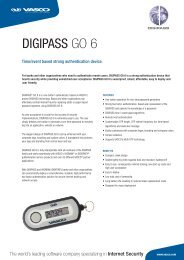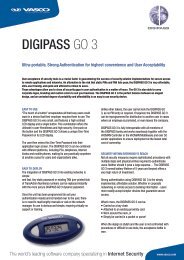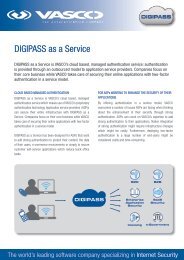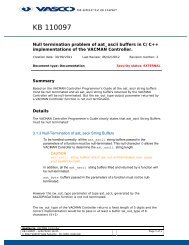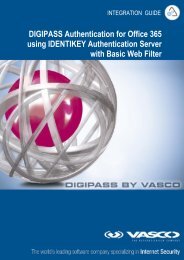Annual Report 2009 (1 MB, pdf) - Vasco
Annual Report 2009 (1 MB, pdf) - Vasco
Annual Report 2009 (1 MB, pdf) - Vasco
You also want an ePaper? Increase the reach of your titles
YUMPU automatically turns print PDFs into web optimized ePapers that Google loves.
The company had $470 and $475 of unrecognized tax benefits as of December 31, <strong>2009</strong> and 2008,<br />
respectively, which have been set aside in a reserve in accordance with ASC 740-10. These amounts are not<br />
included in the above table as the timing of payment of such obligations, if any, is not determinable.<br />
Critical Accounting Policies and Estimates<br />
Management’s Discussion and Analysis of Financial Condition and Results of Operations discusses our<br />
consolidated financial statements, which have been prepared in accordance with accounting principles generally<br />
accepted in the U.S. The preparation of these financial statements requires management to make estimates and<br />
assumptions that affect the reported amounts of assets and liabilities and the disclosure of contingent assets and<br />
liabilities at the date of the consolidated financial statements and the reported amounts of revenue and expenses<br />
during the reporting period.<br />
On an on-going basis, management evaluates its estimates and judgments, including those related to<br />
bad debts, net realizable value of inventory and intangible assets. Management bases its estimates and judgments<br />
on historical experience and on various other factors that are believed to be reasonable under the circumstances,<br />
the results of which form the basis for making judgments about the carrying values of assets and liabilities that<br />
are not readily apparent from other sources. Actual results may differ from these estimates under different<br />
assumptions or conditions. Management believes the following critical accounting policies, among others, affect<br />
its more significant judgments and estimates used in the preparation of its consolidated financial statements.<br />
Revenue Recognition<br />
We recognize revenue in accordance with Financial Accounting Standards Board (FASB) Accounting<br />
Standards Codification (ASC) Subtopic 985-605 that addresses the accounting for revenue transactions involving<br />
software, as well as Staff Accounting Bulletin 104. Revenue is recognized when there is persuasive evidence that<br />
an arrangement exists, delivery has occurred, the fee is fixed or determinable and collection of the revenue is<br />
probable.<br />
Hardware Revenue and License Fees: Revenue from the sale of computer security hardware or the<br />
license of software is recorded upon shipment or, if an acceptance period is allowed, at the later of shipment or<br />
customer acceptance. No significant obligations or contingencies exist with regard to delivery, customer<br />
acceptance or rights of return at the time revenue is recognized.<br />
Maintenance and Support Agreements: Maintenance and support agreements generally call for us to<br />
provide software updates and technical support, respectively, to customers. Revenue on maintenance and<br />
technical support is deferred and recognized ratably over the term of the maintenance and support agreements.<br />
Consulting and Education Services: We provide consulting and education services to our customers.<br />
Revenue from such services is recognized during the period in which the services are performed.<br />
Multiple-Element Arrangements: We allocate revenue to the various elements of the arrangements<br />
based on the estimated fair value of each deliverable, as required by ASC 605-25. The fair value for each element<br />
is based on the price charged when that element is sold separately, renewal rates and other methods, such as<br />
prices established by management. The estimated fair value of undelivered elements is deferred and recorded as<br />
revenue when services are performed or products are delivered.<br />
When tokens and software licenses are included in multiple element arrangements, they are generally<br />
delivered elements in such arrangements. When tokens and software are delivered elements, we use the residual<br />
method for determining the amount of revenue to recognize for token and software licenses if we have vendor<br />
specific objective evidence (VSOE) for all of the undelivered elements. Any discount provided to the customer is<br />
applied fully to the delivered elements in such an arrangement. We defer the revenue for tokens and software in<br />
any multiple element arrangement where we do not have VSOE for any undelivered element. VSOE of fair value<br />
43


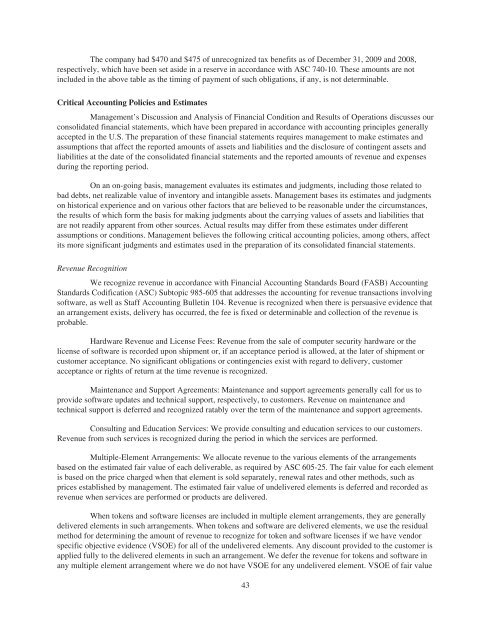

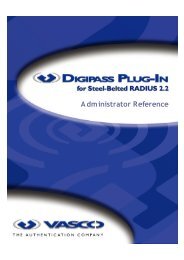
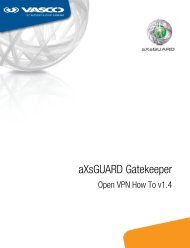
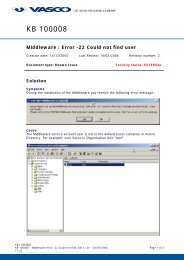
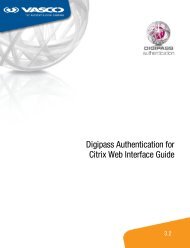
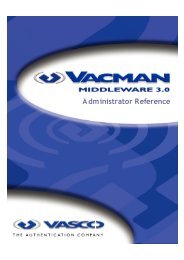
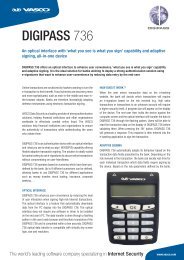
![KB [100006] - Vasco](https://img.yumpu.com/12539350/1/184x260/kb-100006-vasco.jpg?quality=85)

